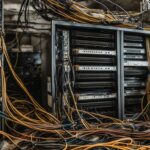A Comprehensive Guide to Server Recycling.
Introduction: The Importance of Server Recycle and Disposal
In today’s digital age, businesses and institutions find themselves in a constant cycle of upgrading and maintaining their IT infrastructure. As a result, the need for responsible server recycle and server disposal practices has become more pressing than ever. Not only is this essential for data protection and legal compliance, but also for our environment.
Why Proper Server Disposal Matters
The process of server disposal isn’t as simple as just tossing away an old piece of equipment. Servers often contain confidential and sensitive data. Improper disposal could lead to data breaches, which can harm a company’s reputation and result in significant fines. Moreover, responsible server disposal ensures that toxic components within servers, like heavy metals, don’t end up in landfills where they can pose environmental and health risks.
The Environmental Impact of Server Recycling
Beyond the realm of data protection, server recycle practices have a broader ecological implication. Servers are packed with materials that, when recycled properly, can be reused, thereby reducing the demand for raw resources. Conversely, when servers are not recycled, they end up in landfills, contributing to electronic waste. E-waste is a growing environmental concern, with harmful chemicals leaching into the ground and affecting both land and water ecosystems. Adopting effective server recycling methods not only conserves resources but also minimizes the negative imprint we leave on our environment.
Understanding the Basics of Server Recycle
As we continue to advance into the digital age, the need for sustainable practices in every industry becomes paramount. In the realm of IT, one of the key areas that demand attention is server recycle. But what does it truly entail?
What Does it Mean to Recycle a Server?
Recycling a server is much more than just repurposing old equipment. Server recycle involves breaking down servers into their component parts, securely erasing all data, and then reusing or recycling the components in an environmentally responsible manner. The main goals are to:
- Protect sensitive and confidential data by ensuring its complete destruction.
- Reduce the environmental impact of e-waste by recycling or reusing server components.
- Extend the lifecycle of valuable materials by recovering and reintroducing them into the production chain.
Common Materials Found in Servers
Servers, like most electronic devices, are a blend of various materials—some valuable and some potentially hazardous. Some of the most common materials found in servers include:
- Metals: These can range from common metals like aluminum and copper to precious metals like gold, silver, and palladium. Through recycling, these metals can be extracted and reused, reducing the need for mining and the environmental damage it entails.
- Plastics: Many server casings and internal components are made of different types of plastics. Recycling these can reduce the need for producing new plastics from crude oil, which can help in conserving non-renewable resources and decreasing greenhouse gas emissions.
- Hazardous Materials: Servers also contain potentially harmful materials like lead, mercury, and cadmium. If not disposed of properly, these can leach into the environment, causing harm to ecosystems and posing health risks to humans.
Recognizing these materials is the first step in the server recycle process, ensuring that each component is directed towards the most appropriate and sustainable end-use.
The Step-by-Step Guide to Effective Server Disposal
The process of server disposal isn’t just about discarding old equipment. It’s a meticulously planned sequence that ensures data protection, environmental responsibility, and legal compliance. Here’s how to go about it:
Preliminary Steps: Data Backup and Wiping
Before initiating any form of disposal, it’s crucial to safeguard the data stored on servers:
- Data Backup: Always start with creating a comprehensive backup of all the data on your server. This ensures that if you need to access it in the future, you have a secure copy readily available.
- Data Wiping: Once backed up, data must be completely erased from the server. Standard delete functions don’t truly remove data; they simply mark the space as available. Instead, use specialized software or methods that overwrite the server’s data multiple times, ensuring that the data is irretrievable.
Choosing the Right Server Disposal Method
Different situations call for varied methods of disposal:
- Repurposing: If the server is still functional but no longer meets your needs, consider reallocating it within your organization or donating it. This extends the device’s life, promoting sustainability.
- Recycling: For servers that are non-functional or obsolete, recycling becomes the most viable option. This involves breaking down the server and recycling its components.
- Secure Destruction: In instances where security is a paramount concern, servers may need to undergo a destruction process that renders them entirely unusable.
Working with Certified Recycling Facilities
When it comes to recycling, not all facilities are created equal:
- Certification Check: Always ensure that the recycling facility holds relevant certifications. These certifications ensure that the facility follows best practices for environmental safety and data protection.
- Track Record: Research the facility’s history. An established track record in server recycle can offer peace of mind, knowing that your equipment is in responsible hands.
- Transparency: Opt for facilities that provide detailed reporting on the recycling process. This not only ensures transparency but also helps in compliance and record-keeping.
By following this guide, businesses can ensure that their server disposal practices are not only effective but also environmentally responsible and secure.
Benefits of Proper Server Recycle Practices
In today’s digital landscape, where electronic waste has become a significant concern, appropriate server recycling is more crucial than ever. Beyond merely being an environmental responsibility, recycling servers brings a range of benefits that many organizations might overlook:
Prolonging the Server Lifecycle
- Resource Efficiency: Every server component, from precious metals to specific alloys, represents significant energy and resource investments. By recycling or repurposing these components, we ensure that the energy and resources invested in creating them get the maximum utilization.
- Economic Advantages: Proper recycling can help retrieve valuable components, potentially leading to financial benefits. The resale of certain components or metals can serve as an additional revenue stream for businesses.
- Reduced E-Waste: As servers are repurposed or their parts reused, the volume of electronic waste hitting our landfills is reduced. This not only minimizes the environmental impact but also aids in cutting down the costs associated with waste disposal.
Safeguarding Sensitive Data during Disposal
- Data Protection: A pivotal concern during server disposal is data security. Proper recycling practices ensure that sensitive data is thoroughly wiped, ensuring no unauthorized access or data breaches.
- Compliance with Regulations: Many industries are bound by regulations regarding data protection and disposal. Adhering to rigorous server recycle and disposal standards helps organizations stay compliant, thus avoiding potential legal repercussions.
- Enhanced Reputation: In the age of data breaches and heightened public awareness about data privacy, showcasing robust server disposal practices can serve as a significant trust factor for stakeholders and customers. A company that prioritizes data security and environmental responsibility can position itself as an industry leader.
Mistakes to Avoid in Server Disposal
Server disposal may seem straightforward, but there are numerous pitfalls that organizations often fall into. Avoiding these common mistakes not only ensures data security and environmental responsibility but can also protect an organization from potential legal and reputational damages.
Improper Data Deletion Methods
- Surface-Level Deletion: Simply pressing ‘delete’ or formatting the server does not erase data permanently. Instead, it marks it as free space, still making it retrievable with the right tools. Always employ thorough data wiping techniques.
- Lack of Verification: Post data deletion, it’s imperative to verify that the data has been entirely removed. Many organizations skip this step, leaving them vulnerable to potential data breaches.
- Overlooking Encrypted Data: Just because data is encrypted doesn’t mean it’s safe to leave on a discarded server. Encrypted data can eventually be decrypted by malicious entities with sufficient time and resources.
Illegal Dumping and Environmental Hazards
- E-Waste in Landfills: Dumping servers in regular landfills is not only environmentally detrimental but can also be illegal in many jurisdictions. Servers contain harmful chemicals and metals that can leach into the soil, posing significant environmental hazards.
- Overlooking Proper Recycling: All server components are not recyclable. Tossing them into generic recycling bins can cause more harm than good. It’s essential to work with certified recycling facilities that understand the specific nuances of server component recycling.
- Ignoring Local Regulations: Different regions have specific regulations and guidelines for electronic waste disposal. Organizations must be aware of and compliant with these local rules to avoid hefty fines and legal consequences.
The Future of Server Recycle and Sustainability
In our rapidly evolving technological world, the question of what happens to outdated or redundant hardware, including servers, is more pressing than ever. As we stand on the cusp of numerous technological breakthroughs, the sustainable management of electronic waste, particularly server recycle, becomes paramount. Let’s explore the emerging horizon:
Emerging Trends in Eco-friendly Server Management
- Modular Server Designs: One of the exciting advancements in server technology is the development of modular designs. These allow individual components to be replaced or upgraded without the need to discard the entire unit, thus prolonging the server’s lifespan and reducing e-waste.
- Energy-Efficient Servers: There’s a growing emphasis on designing servers that consume less power and produce less heat. Not only does this reduce the environmental footprint from energy consumption, but it also means servers have a longer operational life, decreasing the frequency of disposal and recycling needs.
- Cloud Computing: The rise of cloud computing means that fewer physical servers are needed, as multiple virtual servers can run on a single physical server. This transition to virtualization can significantly reduce the total number of physical servers required, subsequently decreasing the environmental impact of their production and disposal.
How Companies are Innovating in Server Disposal
- Advanced Data Wiping Techniques: Companies are harnessing sophisticated software tools that ensure data is not just deleted but is overwritten multiple times, making it virtually irretrievable.
- Recycle and Repurpose Initiatives: Many tech giants are adopting closed-loop recycling systems, wherein old servers are dismantled, and usable parts are incorporated into the production of new servers.
- Collaboration with Certified E-waste Recyclers: Recognizing the specialized nature of server recycling, companies are increasingly partnering with certified e-waste recyclers who adhere to best practices, ensuring minimal environmental harm.
- Server Buyback Programs: Some companies are launching programs where they buy back old servers, offering credits or discounts on newer models. This not only incentivizes proper disposal but also ensures that the servers are recycled or disposed of sustainably.
Conclusion: Making Server Recycle a Standard Practice
In our digital age, with servers acting as the backbone of countless businesses and innovations, the way we handle their end-of-life matters profoundly. Server disposal isn’t just a logistical challenge but an environmental and ethical one. We’re producing electronic waste at an unprecedented rate, and the onus is on us, both as individuals and as a society, to manage this responsibly.
The significance of server recycle goes beyond merely finding a place for outdated technology. It speaks to our larger commitment to sustainability, to reusing and repurposing before discarding, and to mitigating the potentially harmful impacts of improper disposal. By streamlining server recycling practices and championing eco-friendly methods, we not only protect our environment but also preserve valuable resources, foster data security, and pave the way for a more circular economy in tech.
But the shift toward sustainable server management isn’t just an industry or regulatory directive; it’s a collective responsibility. As consumers, businesses, and technologists, understanding and prioritizing server recycle is a crucial step toward a future where technology and ecological responsibility harmoniously coexist. Let’s make server recycling not an afterthought but a standard, ingrained practice for the betterment of our planet.
Learn more about the global challenges of electronic waste on Wikipedia.















